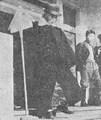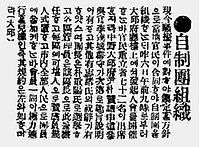Park Jung-yang
| Park Jung-Yang | |
|---|---|
 | |
| Privy Councillor for the Governor-General of Korea | |
|
In office 1927–1939 | |
| Governor-General |
Ugaki Kazushige Yamanashi Hanzō Saitō Makoto Ugaki Kazushige Jirō Minami |
| Governor of Hwanghae Province | |
|
In office 1928–1928 | |
| Governor-General | Yamanashi Hanzō |
|
In office 1921–1923 | |
| Governor-General | Saitō Makoto |
| Governor of North Chungcheong Province | |
|
In office 1923–1925 | |
| Governor-General | Saitō Makoto |
| Personal details | |
| Born |
May 4, 1872 Junae-Myeon, Yangju, Gyeonggi Province |
| Died |
April 23, 1959 (aged 86) Chimsan-dong, Daegu |
| Children | Park Mun-wung, Park Mu-wung, Park Jeong-ja |
| Park Jung-yang | |
| Hangul | 박중양 |
|---|---|
| Hanja | 朴重陽 |
| Revised Romanization | Bag Joong-yang |
| McCune–Reischauer | Park Jung-yang |
| Pen name | |
| Hangul | 해악 or 일소 |
| Hanja | 海岳 or 一笑 |
| Revised Romanization | Haeag or Ilso |
| McCune–Reischauer | Haeahk or Ilso |
| Courtesy name | |
| Hangul | 원근 |
| Hanja | 源根 |
| Revised Romanization | Wongeun |
| McCune–Reischauer | Wongeun |
|
Japanese name: Hochu Segeyo (朴忠重陽) Yamamoto Shin (山本信) | |
Park Jung-yang (Korean: 박중양; Hanja: 朴重陽; sometimes transliterated as Park Joong-yang, May 3, 1874 or 1872 — April 23, 1959) was a Korean Joseon and Japanese-ruled Korean bureaucrat, politician, liberal and social activist. He demolished the castle of Daegueup and the Old Gyungsangdo Provincial Office, and contributed to city planning and road maintenance in Daegu. He was also an advocate for civil rights.
Park went abroad to Japan to study, and later returned to become a bureaucrat in his country. He was appointed as the Mayor of Daegu and the deputy Governor of Gyeongsangbuk-do from 1906 to 1907. Later, he succeeded sequentially in the positions of Governor of Phyeongannamto, Jeollanam-do, Gyeongsangbuk-do, Phyeonganpukto and Chungcheongnam-do. Park was involved in the Japan–Korea Treaty of 1910 and was opposed the March 1st Movement. He also founded the Refrain Club.[1]
Park was also Governor of Hwanghae-do from 1921 to 1923 and Chungcheongbuk-do Provinces from 1923 to 1925.[2] Then, in 1928, he was reappointed Governor of Hwanghae-do province.
Park was pro-Japanese, and was later named a collaborator after World War II. He was nicknamed Haeahk (해악, 海岳), Ilso (일소, 一笑), and Wongeun (원근, 源根). He also had the Japanese names Hochu Segeyo (朴忠重陽) and Yamamoto Shin (山本信).[3]
Early life
Park Jung-yang was born on May 3, 1874/2 in Yangju county, Gyeonggi province or Daegu. The origin of his family is unknown. His father supervised a rent farm and leased it out as well.
In his adolescence, he joined the Independence Club, but it was dispersed due to the repression of the Korean Empire. This caused Park to be disappointed and left him with a bad feeling against the Korean Empire.
International study
In 1897, he was selected as a Korean state student to go abroad to study in Japan. Park supported himself during the study, because his family was poor. From 1897 to 1900, he studied in the Aoyama middle school. In 1900, he entered Dokyo buki high school as a banking major.[4] Then, he added a double-major in the Japanese police study there.[4] After the graduation, Park adopted Neo-Confucianism and the 'Theory of the national prosperity and the military power' from Ito Hirobumi.
At the time, he chose the Japanese name Yamamoto Shin. Park also became a Japanese petty bureaucrat. He tried to introduce the parliamentary system to the Imperial Korean government, but the Korean government refused.[5]
In 1903, he returned and passed the probation period as a civil officer of Imperial Korea. After returning to Korea, Park continued to advocate a pro-Japanese position.
Career
Korean Empire era
In 1903, Park successfully filled various government posts, and was also appointed as a staff of the Public Administration Agency. In 1905, he served as a military interpreter during the Russo-Japanese War.[6] In November 1905, he was appointed to the staff of the Farming, Commerce and Industry Department. He resigned when the Japan–Korea Treaty of 1905 was signed. On May 5, he was appointed as an engineer of the National Defense Department (군부;軍部) engineer, and accompanied Prince Yi Kang to go to Japan.[7] Two months later, he returned to his country.
In 1906, Park was promoted to Governor of Daegu County.[8] Then, after a short period, he was promoted again to the Acting Governor of the Gyeongsangbuk-do. During the term, Park tore down the castle of Daegueup without official permission[9] In early 1906, he applied for permission from the Korean government, but it was refused. The government tried to punish him for the action, but he acquired protection from Ito Hirobumi.[9] Later, he modernized the Daegu city planning and road maintenance.
He strove in building modern hospitals, medicine schools and colleges, and successfully built the Dojin hospital and its affiliated medical school. He was also a supporter of the free press, including journals which satirized him. His idea was that the freedom of the press is a must to supervise the government.
In 1907, he became a governor of Phyeongannamto and Phyeonganpukto, and in 1910, the Governor of Chungcheongnam-do.
Japanese rule

When the Japan–Korea Treaty of 1910 was signed in August, 1910, Park remained as the Governor of Chungcheongnam-do until 1915. From 1916 to 1920, he was a member of Japanese Government-General of Korea's Privy Council. In 1919, he opposed the March 1st Movement, and founded the Refrain club on 6 April in response.[1] His old friends Seo Jae-pil and Yun Chi-ho cut off relations with him due to this.
He was appointed as the Governor of Hwanghae Province in 1921, and the Governor of North Chungcheong Province in 1923 to 1925. After the 1923 Great Kantō earthquake, he appealed to the Japanese government to release the arrested Koreans, and asserted that the Koreans were not involved in the criminal cases which occurred during the earthquake. In November 1924, he was accused in a sex abuse scandal, but the accuser woman suddenly died; three years later, the charge against him was dismissed. In 1928, he was re-appointed as the Governor of Hwanghae Province.
He governed the civilians through a regulated bureaucracy system, often with warning and several days of confinement instead of punishment, and suppressed the power of the Japanese police and soldiers to harass civilians, even putting them in confinement as well. Sometimes, the bureaucrats were imprisoned, but the Japanese police never arrested him, because he was especially trusted by the Japanese Governor-General of Korea, which pleased many Joseon people.
World War II era
In 1927 to 1939, he was a member of Japanese Government-General of Korea's Privy Council; and in 1936, the advisor of Japanese Government-General of Korea's Privy Council.[8] Seven years later, he was elected as the vice-chairman of the council. In 1940, he changed name to Hochu Segeyo as per the Japanese Sōshi-kaimei.
In October 22, 1941, he was appointed as the adviser of the Fight-patriotic of Joseon Group, which merged with the Peoples Mind Alliance in January 1943.[7] During the Asia-Pacific War, he contributed to encourage and comfort the Japanese troops, as in 1942 and 1943, when he was sent on a consolatory visit to the Japanese troops stationed in Singapore. In 1943, he was appointed as Vice-Chairman of Japanese Government-General of Korea's Privy Council. On 3 April 1945, he was elected as a congressman in the House of Peers.[4]
Due to his cooperation with the Japanese Empire and the Japanese Governor-General of Korea, he was listed as a Pro-Japanese collaborators in Korea by the Institute for Research in Collaborationist Activities in 2008.
Later years

Korea was liberated on August 15, 1945, after the end of World War II, but Park stayed in Daegu. He mocked the Korean independence activists for talking about their heroic deeds in the independence battle.
After October 1945, as some pro-Japanese group begged for their lives, he ridiculed Korean resistance activists. On January 1, 1949, he was arrested by the police of National Traitor Special Punishment Committee and charged under the National Traitor Law. But, Park maintained his innocence at the court and stood by his pro-Japanese belief.
The Joseon dynastys was society of more darkness, Japanese ruled time was reformed of modern Korea. Civil servants purpose was social welfare. Japanese ruled time was "squeeze the peoples blood's", it's assert that also unaware of politics meaning, prejudice of causeless Japanese hates.[1]
In February 1949, he was released on bail due to bronchial pneumonia and asthma. Later, he continued to criticize President Syngman Rhee, Kim Gu, Lee See-yeong and Ham Tae-yeong as "patrioteers". In 1955, Rhee tried to confine Park to a psychiatric hospital, but failed. Park Jung-yang died in Daegu on April 23, 1959 due to pneumonia.
Personal life
Family
One version says he was an adopted son of Ito Hirobumi.[8]
His first son Park Mun-wung was the succeeding mayor of Cheongdo, Cheongsong, Sangju, and Dalseong in North Gyeongsang Province in 1940s.
Pets

He had a pet named Stick Mr. Park. The pet was named because Park always carried a long stick, sometime called the "Enlightened Stick".[10]
Books
- 《Park Jungyang's Diary》(박중양일기, 朴重陽日記)
- 《Sulhoi》(술회, 述懷)
- 《Sinnyonsogam》(신년소감, 新年所感)
- 《Pokdosatyopyonchipjaryo》(폭도사편집자료, 暴徒史編輯資料) (1907)
Gallery
 Park Jung-yang (1941)
Park Jung-yang (1941) Park Jung-yang (1949.01)
Park Jung-yang (1949.01) Park Jung-yang (1907.06)
Park Jung-yang (1907.06) Park Jung-yang (1908)
Park Jung-yang (1908) Park Jung-yang (1925)
Park Jung-yang (1925) Park Jung-yang (1932)
Park Jung-yang (1932) Report of Demolition Daegu Castle (1906.10)
Report of Demolition Daegu Castle (1906.10) A Handwriting letter to Emperor Kojong (1909.11.01)
A Handwriting letter to Emperor Kojong (1909.11.01) A calligraphy art (1933.11.30)
A calligraphy art (1933.11.30) A calligraphy art, send to Hoseo News (1932.03.01)
A calligraphy art, send to Hoseo News (1932.03.01) Holographic Report of Business trip orders (1938)
Holographic Report of Business trip orders (1938) News of Refrain club, his founding club(1919.04.16)
News of Refrain club, his founding club(1919.04.16)
See also
|
Notes
- 1 2 3 "일제가 현대 조선 개신" 해방후에도 망발…친일파 박중양] 매일신문. Idaegumail news (in Korean). 25 January 2010. Retrieved 19 August 2015.
- ↑ Park Jung-yang (Korean)
- ↑ 경상감영 정문 '영남포정사 ' 원래 모습 찾아냈다. Idaegumail news (in Korean). 10 January 2012. Retrieved 19 August 2015.
- 1 2 3 Park Jung-yang
- ↑ Institute for Research in Collaborationist Activities, 《National issues Institute 9》(Seoul:Institute for Research in Collaborationist Activities, 1996) pp. 16
- ↑ Park Jung-yang (Korean)
- 1 2 Park Jung-yang
- 1 2 3 Park Jung-yang (Korean)
- 1 2 "[역사속의 영남사람들 .11] 박중양]". TheYoungnamilbo. 9 March 2004. Retrieved 19 August 2015.
- ↑ "[문화칼럼] 大邱城(대구성)을 짓자". Idaegumail news (in Korean). 7 September 2012. Retrieved 19 August 2015.
References
- Park Eungyung(1999), 일제하 조선인관료 연구, Seoul, Korea: Hakminsa.
- 반민족문제연구소(1993), 친일파 99인 1, Seoul, Korea: Dolbegye. ISBN 8971990112.
- Lim Jong-guk(1991), 실록 친일파, Seoul, Korea: Dolbegye. ISBN 9788971990360.
- 민족경제연구소(1948), 친일파 군상, Seoul, Korea: 삼성출판사.
External links
| Wikisource has original text related to this article: |
| Wikimedia Commons has media related to Park Jung-yang. |
- Park Jung-yang (Korean)
- Park Jung-yang (Korean)
- Park Jung-yang (Korean)
- Park Jung-yang:Korea historical person information (Korean)
- 大邱の近代化-朴重陽 (Japanese)
- 日本帝國勅選貴族院議員一覽 (Japanese)
- "일제가 현대 조선 개신" 해방후에도 망발…친일파 박중양 i-Daegumail news 2010. 01.25 (Korean)
- 순종의 남행에는 친일파 뿐이었다 The Dailian News 2010.01.30 (Korean)
- "순종 남행이 박중양의 정치적 입지 높여" The Dailian News 2010.01.30 (Korean)
- 친일중의 친일 ‘3·1운동 자제단’은 누구? The Hangyeolye 2010.03.01 (Korean)
